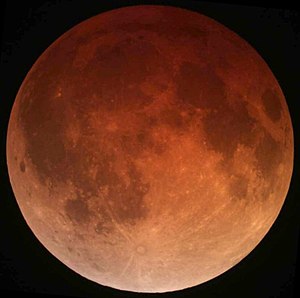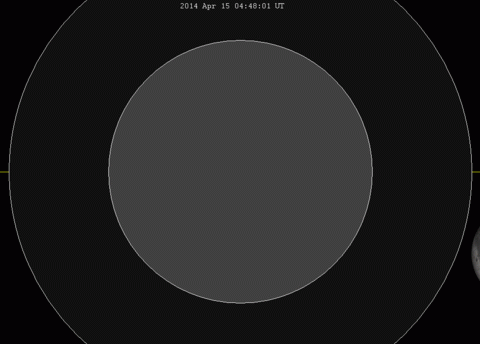| Revision as of 22:27, 18 May 2014 view source65.95.193.79 (talk) What rarely happens in a lunar eclipse← Previous edit | Revision as of 23:02, 18 May 2014 view source Mindmatrix (talk | contribs)Autopatrolled, Administrators187,420 editsm Reverted edits by 65.95.193.79 (talk) to last version by DumbBOTNext edit → | ||
| Line 120: | Line 120: | ||
| ] | ] | ||
| ] | ] | ||
| It is also when the moon covers the sun which realeses a gas that is known as methane and it kills ponies | |||
Revision as of 23:02, 18 May 2014
For other uses, see Lunar eclipse (disambiguation). Not to be confused with Solar eclipse.
A lunar eclipse occurs when the Moon passes directly behind the Earth into its umbra (shadow). This can occur only when the Sun, Earth, and Moon are aligned (in "syzygy") exactly, or very closely so, with the Earth in the middle. Hence, a lunar eclipse can only occur the night of a full moon. The type and length of an eclipse depend upon the Moon's location relative to its orbital nodes.
Unlike a solar eclipse, which can only be viewed from a certain relatively small area of the world, a lunar eclipse may be viewed from anywhere on the night side of the Earth. A lunar eclipse lasts for a few hours, whereas a total solar eclipse lasts for only a few minutes at any given place, due to the smaller size of the moon's shadow. Also unlike solar eclipses, lunar eclipses are safe to view without any eye protection or special precautions, as they are dimmer than the full moon.
For the date of the next eclipse see the section Recent and forthcoming lunar eclipses.
Types of lunar eclipse



The shadow of the Earth can be divided into two distinctive parts: the umbra and penumbra. Within the umbra, there is no direct solar radiation. However, as a result of the Sun's large angular size, solar illumination is only partially blocked in the outer portion of the Earth's shadow, which is given the name penumbra.
A penumbral eclipse occurs when the Moon passes through the Earth's penumbra. The penumbra causes a subtle darkening of the Moon's surface. A special type of penumbral eclipse is a total penumbral eclipse, during which the Moon lies exclusively within the Earth's penumbra. Total penumbral eclipses are rare, and when these occur, that portion of the Moon which is closest to the umbra can appear somewhat darker than the rest of the Moon.
A partial lunar eclipse occurs when only a portion of the Moon enters the umbra. When the Moon travels completely into the Earth's umbra, one observes a total lunar eclipse. The Moon's speed through the shadow is about one kilometer per second (2,300 mph), and totality may last up to nearly 107 minutes. Nevertheless, the total time between the Moon's first and last contact with the shadow is much longer, and could last up to 4 hours. The relative distance of the Moon from the Earth at the time of an eclipse can affect the eclipse's duration. In particular, when the Moon is near its apogee, the farthest point from the Earth in its orbit, its orbital speed is the slowest. The diameter of the umbra does not decrease appreciably within the changes in the orbital distance of the moon. Thus, a totally eclipsed Moon occurring near apogee will lengthen the duration of totality.
The timing of total lunar eclipses are determined by its contacts:
- P1 (First contact): Beginning of the penumbral eclipse. The Earth's penumbra touches the Moon's outer limb.
- U1 (Second contact): Beginning of the partial eclipse. The Earth's umbra touches the Moon's outer limb.
- U2 (Third contact): Beginning of the total eclipse. The Moon's surface is entirely within the Earth's umbra.
- Greatest eclipse: The peak stage of the total eclipse. The Moon is at its closest to the center of the Earth's umbra.
- U3 (Fourth contact): End of the total eclipse. The Moon's outer limb exits the Earth's umbra.
- U4 (Fifth contact): End of the partial eclipse. The Earth's umbra leaves the Moon's surface.
- P2 (Sixth contact): End of the penumbral eclipse. The Earth's penumbra no longer makes contact with the Moon.
Appearance
The Moon does not completely disappear as it passes through the umbra because of the refraction of sunlight by the Earth’s atmosphere into the shadow cone; if the Earth had no atmosphere, the Moon would be completely dark during an eclipse. The red coloring arises because sunlight reaching the Moon must pass through a long and dense layer of the Earth’s atmosphere, where it is scattered. Shorter wavelengths are more likely to be scattered by the air molecules and the small particles, and so by the time the light has passed through the atmosphere, the longer wavelengths dominate. This resulting light we perceive as red. This is the same effect that causes sunsets and sunrises to turn the sky a reddish color; an alternative way of considering the problem is to realize that, as viewed from the Moon, the Sun would appear to be setting (or rising) behind the Earth. Such a total eclipse of the moon is sometimes referred to as a blood moon.
The amount of refracted light depends on the amount of dust or clouds in the atmosphere; this also controls how much light is scattered. In general, the dustier the atmosphere, the more that other wavelengths of light will be removed (compared to red light), leaving the resulting light a deeper red color. This causes the resulting coppery-red hue of the Moon to vary from one eclipse to the next. Volcanoes are notable for expelling large quantities of dust into the atmosphere, and a large eruption shortly before an eclipse can have a large effect on the resulting color.
Selenelion
A selenelion or selenehelion occurs when both the Sun and the eclipsed Moon can be observed at the same time. This can only happen just before sunset or just after sunrise, and both bodies will appear just above the horizon at nearly opposite points in the sky. This arrangement has led to the phenomenon being referred to as a horizontal eclipse. There are typically a number of high ridges undergoing sunrise or sunset that can see it. Indeed, the reddened light that reaches the Moon comes from all the simultaneous sunrises and sunsets on the Earth. Although the Moon is in the Earth’s umbra, the Sun and the eclipsed Moon can both be seen at the same time because the refraction of light through the Earth’s atmosphere causes each of them to appear higher in the sky than their true geometric position.
Danjon scale
The following scale (the Danjon scale) was devised by André Danjon for rating the overall darkness of lunar eclipses:
- L=0: Very dark eclipse. Moon almost invisible, especially at mid-totality.
- L=1: Dark eclipse, gray or brownish in coloration. Details distinguishable only with difficulty.
- L=2: Deep red or rust-colored eclipse. Very dark central shadow, while outer edge of umbra is relatively bright.
- L=3: Brick-red eclipse. Umbral shadow usually has a bright or yellow rim.
- L=4: Very bright copper-red or orange eclipse. Umbral shadow is bluish and has a very bright rim.
Lunar eclipse in mythology
Several cultures have myths related to lunar eclipses. The Egyptians saw the eclipse as a sow swallowing the moon for a short time; other cultures view the eclipse as the moon being swallowed by other animals, such as a jaguar in Mayan tradition, or a three legged toad in China. Some societies thought it was a demon swallowing the moon, and that they could chase it away by throwing stones and curses at it.
Occurrence
See also: Saros (astronomy) and Eclipse cycleEvery year there are at least two lunar eclipses and as many as five, although total lunar eclipses are significantly less common. If one knows the date and time of an eclipse, it is possible to predict the occurrence of other eclipses using an eclipse cycle like the saros.
Recent and forthcoming lunar eclipses
Main article: List of 21st-century lunar eclipses Further information: Lists of lunar eclipsesEclipses only occur during an eclipse season, when the Sun is close to either the ascending or descending node of the Moon.
| Lunar eclipses | |||||||
| 1998–2002 | 2002–2005 | 2006–2009 | 2009–2013 | 2013–2016 | 2016–2020 | 2020–2023 | 2024–2027 |
Gallery
-
 The beginning of the November 2003 lunar eclipse
The beginning of the November 2003 lunar eclipse
-
 December 21, 2010 Lunar Eclipse
December 21, 2010 Lunar Eclipse
-
 Painting by Lucien Rudaux, showing what a lunar eclipse might look like when viewed from the surface of the moon. The moon's surface appears red because the only sunlight available is refracted through the Earth's atmosphere on the edges of the earth, as shown in the sky in this painting.
Painting by Lucien Rudaux, showing what a lunar eclipse might look like when viewed from the surface of the moon. The moon's surface appears red because the only sunlight available is refracted through the Earth's atmosphere on the edges of the earth, as shown in the sky in this painting.
-
 Lunar eclipse of April 15, 2014, taken from Montevideo, Uruguay.
Lunar eclipse of April 15, 2014, taken from Montevideo, Uruguay.
 Simulation of the appearance of the moon just before, during and just after a total lunar eclipse (the April 15, 2014 one in this example)
Simulation of the appearance of the moon just before, during and just after a total lunar eclipse (the April 15, 2014 one in this example)
See also
Template:Misplaced Pages books
References
- Hannu Karttunen. Fundamental Astronomy. Springer.
- Clarke, Kevin. "On the nature of eclipses". Inconstant Moon. Cyclopedia Selenica. Retrieved 19 December 2010.
- Fred Espenak and Jean Meeus. "Visual Appearance of Lunar Eclipses". NASA.
The troposphere and stratosphere act together as a ring-shaped lens that refracts heavily reddened sunlight into Earth's umbral shadow
{{cite web}}: Cite has empty unknown parameter:|1=(help) - Nigro, Nicholas (2010). Knack Night Sky: Decoding the Solar System, from Constellations to Black Holes. Globe Pequot. pp. 214–5. ISBN 978-0-7627-6604-8.
- "In Search of Selenelion". Observing Blog - SkyandTelescope.com. 2010-06-26. Retrieved 2011-12-08.
- Paul Deans and Alan M. MacRobert. "Observing and Photographing Lunar Eclipses". Sky and Telescope.
- "The Lunar Eclipse: Tidbits Behind the Phenomenon?". 2007-28-15. Retrieved 2011-12-02.
{{cite web}}: Check date values in:|date=(help)
Further reading
- Bao-Lin Liu, Canon of Lunar Eclipses 1500 B.C.-A.D. 3000, 1992
- Jean Meeus and Hermann Mucke Canon of Lunar Eclipses. Astronomisches Büro, Vienna, 1983
- Espenak, F., Fifty Year Canon of Lunar Eclipses: 1986-2035. NASA Reference Publication 1216, 1989
External links
- "Lunar Eclipse Essentials": video from NASA
- Animated explanation of the mechanics of a lunar eclipse, University of South Wales
- U.S. Navy Lunar Eclipse Computer
- NASA Lunar Eclipse Page
- Search among the 12,064 lunar eclipses over five millennium and display interactive maps
- Lunar Eclipses for Beginners
- Tips on photographing the lunar eclipse from New York Institute of Photography
| Moon | ||
|---|---|---|
| Outline | ||
| Physical properties |  | |
| Orbit | ||
| Surface and features | ||
| Science | ||
| Exploration | ||
| Time-telling and navigation | ||
| Phases and names | ||
| Daily phenomena | ||
| Related |
| |


